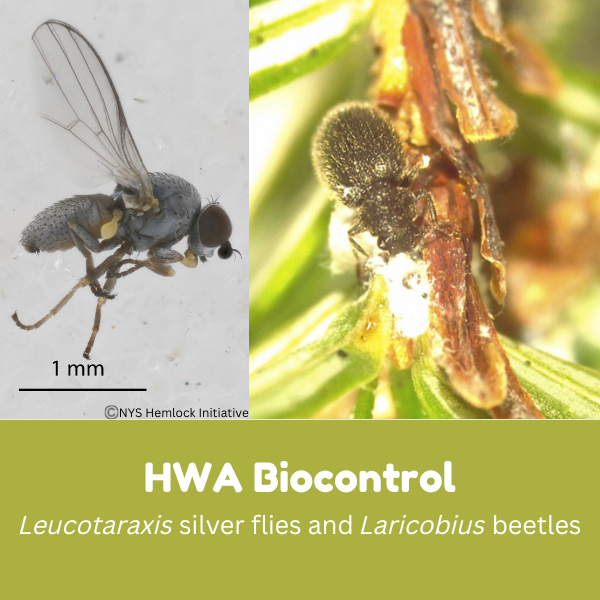This article was featured in the 2022 Autumn Newsletter by Caroline Marschner-NYS Hemlock Initiative/Cornell University.
Finding effective biological control options is a critical piece of the long-term solution to eastern hemlock conservation in the face of hemlock woolly adelgid (HWA), an invasive insect that is killing hemlock on the East Coast. Cornell University’s NYS Hemlock Initiative is researching two different kinds of insects that are HWA eating machines: Laricobius beetles and Leucotaraxis silver flies. HWA has two generations per year; Laricobius feed on the overwintering generation, while the silver flies are found feeding on both generations. These three HWA specialists we are working with come from the Pacific Northwest, where HWA is native and kept from reaching outbreak populations by a suite of predators. Each spring we go out to the Pacific Northwest to collect western hemlock foliage with HWA and their predators. We bring the foliage back to the Cornell quarantine facility, and collect the HWA predators as they emerge.

Laricobius nigrinus is a tiny black beetle that spends all fall and winter as an adult, feeding on developing HWA. They lay their eggs in the early spring, and freshly hatched larvae feed on HWA eggs. When they are ready to pupate, they drop to the ground and burrow into the soil, where they stay until emerging as adults in the fall.

The larvae of silver flies feed on the eggs of both generations of HWA. After that they become inactive (diapause) until they emerge as adults, usually the following spring, to lay their eggs near HWA so their larvae will have a nearby food source.
Silver fly larvae are so small you need a microscope to find them, but they are voracious egg eaters. We are still studying silver flies to learn more about their life cycles, both in the Pacific Northwest and where they are being released on the East Coast.

Once the HWA predators are ready to release, we work with partners all over the state to find promising release sites for them. It has been our pleasure to work with SLELO PRISM, Oswego County, NYS Parks (NYS Office of Parks, Recreation, and Historic Places), and the NYS Department of Conservation to plan the first biocontrol release in SLELO PRISM this fall. A lot of work goes into surveying for HWA, finding good biocontrol sites, securing all the permits for releases, and treating hemlocks; many thanks to all of these partners as we’ve worked together to make this fall’s SLELO biocontrol releases a reality.


